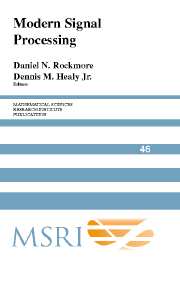Book contents
- Frontmatter
- Contents
- Introduction: A New Generation of Signal Processing
- Hyperbolic Geometry, Nehari's Theorem, Electric Circuits, and Analog Signal Processing
- Engineering Applications of the Motion-Group Fourier Transform
- Fast X-Ray and Beamlet Transforms for Three-Dimensional Data
- Fourier Analysis and Phylogenetic Trees
- Diffuse Tomography as a Source of Challenging Nonlinear Inverse Problems for a General Class of Networks
- An Invitation to Matrix-Valued Spherical Functions: Linearization of Products in the Case of Complex Projective Space P2(ℂ)
- Image Registration for MRI
- Image Compression: The Mathematics of JPEG 2000
- Integrated Sensing and Processing for Statistical Pattern Recognition
- Sampling of Functions and Sections for Compact Groups
- The Cooley-Tukey FFT and Group Theory
- Signal Processing in Optical Fibers
- The Generalized Spike Process, Sparsity, and Statistical Independence
Hyperbolic Geometry, Nehari's Theorem, Electric Circuits, and Analog Signal Processing
Published online by Cambridge University Press: 25 June 2025
- Frontmatter
- Contents
- Introduction: A New Generation of Signal Processing
- Hyperbolic Geometry, Nehari's Theorem, Electric Circuits, and Analog Signal Processing
- Engineering Applications of the Motion-Group Fourier Transform
- Fast X-Ray and Beamlet Transforms for Three-Dimensional Data
- Fourier Analysis and Phylogenetic Trees
- Diffuse Tomography as a Source of Challenging Nonlinear Inverse Problems for a General Class of Networks
- An Invitation to Matrix-Valued Spherical Functions: Linearization of Products in the Case of Complex Projective Space P2(ℂ)
- Image Registration for MRI
- Image Compression: The Mathematics of JPEG 2000
- Integrated Sensing and Processing for Statistical Pattern Recognition
- Sampling of Functions and Sections for Compact Groups
- The Cooley-Tukey FFT and Group Theory
- Signal Processing in Optical Fibers
- The Generalized Spike Process, Sparsity, and Statistical Independence
Summary
Underlying many of the current mathematical opportunities in digital signal processing are unsolved analog signal processing problems. For instance, digital signals for communication or sensing must map into an analog format for transmission through a physical layer. In this layer we meet a canonical example of analog signal processing: the electrical engineer's impedance matching problem. Impedance matching is the design of analog signal processing circuits to minimize loss and distortion as the signal moves from its source into the propagation medium. This paper works the matching problem from theory to sampled data, exploiting links between H∞ theory, hyperbolic geometry, and matching circuits. We apply J. W. Helton's significant extensions of operator theory, convex analysis, and optimization theory to demonstrate new approaches and research opportunities in this fundamental problem.
1. The Impedance Matching Problem
Figure 1 shows a twin-whip HF (high-frequency) antenna mounted on a superstructure representative of a shipboard environment. If a signal generator is connected directly to this antenna, not all the power delivered to the antenna can be radiated by the antenna. If an impedance mismatch exists between the signal generator and the antenna, some of the signal power is reflected from the antenna back to the generator. To effectively use this antenna, a matching circuit must be inserted between the signal generator and antenna to minimize this wasted power.
Figure 2 shows the matching circuit connecting the generator to the antenna. Port 1 is the input from the generator. Port 2 is the output that feeds the antenna.
Information
- Type
- Chapter
- Information
- Modern Signal Processing , pp. 1 - 62Publisher: Cambridge University PressPrint publication year: 2004
